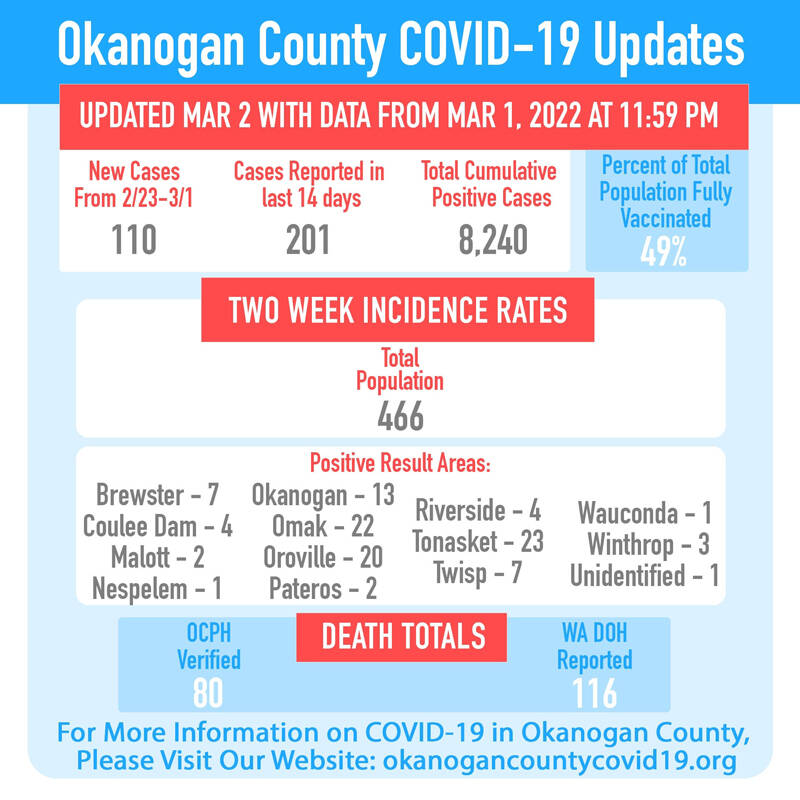OKANOGAN – The two-week COVID-19 Incident Rate in Okanogan County continues to drop at a dramatic rate, now at 466 new cases in 100,000 of population, according to Okanogan County Public Health’s March 2 update.
The number of positive cases seems to be on a steady incline, dropping by around 50 percent in each of the previous two updates.
In this latest update from Public Health, there were 201 new cases of the virus reported (down from 392) in that two-week period. However, there were 101 new cases in the seven days prior to the update. Total positive cases in the county since testing began stands at 8,240 and 80 verified deaths.
In Public Health’s cumulative totals for people testing positive, Omak has the highest number with 1,991 up 10 since the prior 14-day update on Feb. 23. The next highest is Brewster, with 1,329 (up five); Tonasket, 1,090 (up 23); Oroville, 912 (up 20); Okanogan, 881 (up 12); Twisp, 381 (up seven); Pateros, 255 (up three); Winthrop, 249; Nespelem, 246 (up one); Riverside, 195 (up four); Coulee Dam, 203 (up three); Malott, 171 (up two); Carlton, 67 (down one); Elmer City, 74; Loomis, 54; “unidentified,” 45 (up one); Conconully, 40; Wauconda, 25 (up one); Methow, 17 and Mazama, 15.
The most deaths from the virus have been in Tonasket residents with 17. The next highest number of deaths attributed to COVID-19 is in Brewster, eight, followed by Omak, three and Pateros, two. The towns of Malott, Okanogan, Carlton and Oroville have had one death each. A total of 46 deaths are listed as “unidentified.”
The largest number of positive COVID-19 cases in the county is in the 20-39 age group with 2,409 (up 24) and three deaths. The 40-59 age group has had 2,047 (up 15) and six deaths. Next is the 0-19 age group with 2,274 (down 25) and no fatalities. Those aged 60-79 have had 1,182 cases (up 10) and 40 deaths. Age 80 and above have had 232 cases (up three) and 12 fatalities. There were five cases and 19 deaths listed in the “unreleased” category.
Statewide
The Washington State Department of Health (DOH) reported a total of 1,427,013 confirmed cases as of March 1. There have been 11,954 COVID-19 deaths in Washington.
Vaccine booster dose data is now available on the DOH’s COVID-19 Data Dashboard doh.wa.gov/emergencies/covid-19/data-dashboard. The added data includes “People who Received a Booster Dose” and “People Eligible for a Booster Dose” broken down at the state and county-levels by sex, age and race/ethnicity coverage.
As of Feb. 28, a total of 2,648,723 people across the state have received a booster dose. A booster dose is an additional dose of any COVID-19 vaccine administered to someone age 12 or older, including certain immunocompromised people who received a third dose. The newly added booster dose data can be found by selecting the “Vaccinations” tab and navigating to the sections titled “How many people are getting vaccinated?” and “Who is getting vaccinated?”
Everyone 12 and older should receive a booster dose at least five months after receiving the second dose of an mRNA vaccine (Pfizer-BioNTech or Moderna) or two months after receiving the single-shot Johnson & Johnson vaccine, according to DOH. A third dose is recommended for certain immunocompromised individuals who did not adequately develop immunities with the initial two-dose vaccine series. Those who are eligible to receive a fourth dose are only counted once.
“COVID-19 vaccines offer powerful protection against severe illness, hospitalization, and death, and booster shots extend that protection,” said Tao Sheng Kwan-Gett, MD, MPH, Chief Science Officer. “Adding booster dose data to the dashboard gives us a better understanding of vaccination rates across our state.”
Due to a difference in the denominator, booster dose coverage on the dashboard may appear higher than coverage rates for people initiating vaccination and people who are fully vaccinated. The denominator for boosters includes everyone 12 and older who is fully vaccinated and eligible for a booster dose, whereas vaccination coverage includes the total population of Washingtonians age five and older. Booster doses are not shown for people ages five through 11 because the age group is not currently authorized to receive a booster. In keeping with DOH’s Small Number Guidance, county-level booster counts may be suppressed to protect people’s privacy. Additionally, due to limitations with small area population estimates and people moving out of Washington state, vaccination coverage rates may exceed 100 percent for certain age or race/ethnicity groups.
For more information on COVID-19, visit the Washington State Department of Health’s website (www.doh.wa.gov/).






